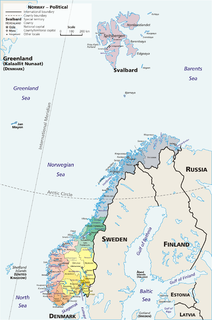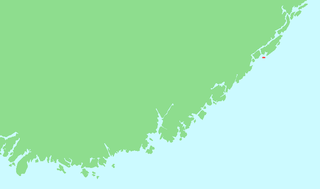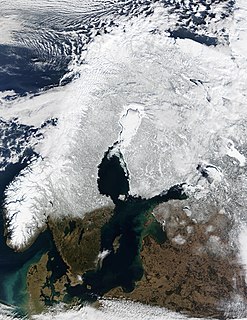
Hisøy is a former municipality in Aust-Agder county, Norway. The 10-square-kilometre (3.9 sq mi) municipality existed from 1881 until 1992 when it was merged into the municipality of Arendal. At the time of its dissolution, it was the smallest municipality in the whole county. The municipality encompassed the islands of Hisøya, Gjervoldsøy, Havsøya, Ærøya, Store Torungen, Lille Torungen, and several other small, unpopulated islands. The administrative centre was the village of Kolbjørnsvik on Hisøya island. Hisøy Church was the main church for the municipality, located in the village of His in the central part of Hisøya.

Austre Moland is a former municipality in Aust-Agder county, Norway. The municipality existed from 1838 until 1962 when it was merged into the neighboring municipality of Arendal. The administrative centre was at Brekka where the Austre Moland Church is located.

Eydehavn or Eydehamn is a village in the municipality of Arendal in Aust-Agder county, Norway. The village is located about 10 kilometres (6.2 mi) northeast of the centre of the town of Arendal, about 2 kilometres (1.2 mi) northeast of the village of Saltrød, about 2 kilometres (1.2 mi) south of the village of Strengereid, and just across the Tromøysundet strait from Kongshamn on the island of Tromøy. The village is named after Sam Eyde, the Norwegian engineer and industrialist. The local sports team is called IL Sørfjell. Eydehavn has about 1,100 residents as of 2015.

Tromøya or Tromøy is the largest island in Southern Norway. The 28.6-square-kilometre (11.0 sq mi) island is entirely located in the municipality of Arendal in Aust-Agder county, Norway. The island has about 5,300 residents which gives it a population density of about 185 inhabitants per square kilometre (480/sq mi). The island is located directly across the harbor from the town of Arendal. The highest point on the island is the 95-metre (312 ft) tall Vardåsen. The island is separated from the mainland to the north by the Tromøysundet strait and it is separated from the island of Hisøya to the southwest by the Galtesundet strait.

Ærøya is an unpopulated island in Arendal municipality in Aust-Agder county, Norway. The 0.12-square-kilometre (30-acre) island lies along the Skaggerak coast about 700 metres (2,300 ft) south of the larger island of Hisøya. The islands of Havsøya and Merdø lie to the northeast, the islands of Store Torungen and Lille Torungen lie to the southeast, and the island of Gjervoldsøy lies to the west.

Brattekleiv is a village in Arendal municipality in Aust-Agder county, Norway. The village is located along the Galtesundet strait on the southwestern shore of the island of Tromøy. The village lies about 1 kilometre (0.62 mi) southwest of the town of Arendal which is located across the strait. The smaller industrial village of Pusnes lies immediately north of Brattekleiv, the small village of Revesand lies just south of the village, and the village of Færvik lies a short distance to the east.

Færvik is a village in Arendal municipality in Aust-Agder county, Norway. The village is located on the southwestern part of the island of Tromøy. It sits east of Pusnes and Brattekleiv and north of Revesand. Færvik Church is located just southwest of the village. Færvik was the administrative centre of the old Tromøy municipality from 1878 until 1992.

Pusnes is a village in Arendal municipality in Aust-Agder county, Norway. The village is located on the southwestern edge of the island of Tromøy, just across the strait from the town of Arendal. There is a ferry that regularly crosses the strait from Pusnes to Arendal. Pusnes is primarily an industrial area.

Revesand is a village in Arendal municipality in Aust-Agder county, Norway. The village is located at the southern coast of the island of Tromøy, about 1 kilometre (0.62 mi) north of the island outport of Merdø.

Saltrød is a village in Arendal municipality in Aust-Agder county, Norway. The village is located along the Norwegian County Road 410, about 5 kilometres (3.1 mi) northeast of the town of Arendal and about 2 kilometres (1.2 mi) southwest of the village of Eydehavn. The village lies along the Tromøysundet strait, looking across the water towards the island of Tromøy. Stokken Church is located in Saltrød.

Åmdalsøyra or Omdalsøyra is a village in Arendal municipality in Aust-Agder county, Norway. The village is located along the Tromøysundet strait on the northern shore of the island of Tromøy. The village of Kongshavn lies just to the southwest of Åmdalsøyra and the village of Eydehavn lies just across the strait on the mainland.
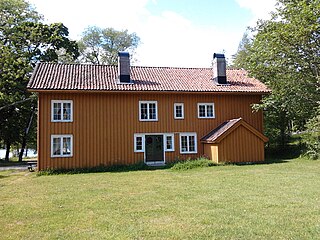
Hove Farm is an original undivided farm (matrikkelgård) on the southwest part of the island of Tromøy in the municipality of Arendal in Aust-Agder county, Norway. The farm is located on a headland, with the sea behind it to the southeast and facing Hove Bay (Hovekilen) to the northwest. Hove Bay is a protected marine area, accessible only to small vessels. The islands of Merdø and Gjesøya lies closest to Hove. Until 1942, Hove Farm had a single registration number and a single owner. The farm was purchased by the state in 1942, and was then used by the German occupation forces during the Second World War. Today the farm belongs to the municipality of Arendal.
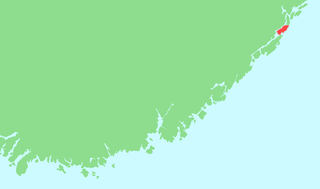
Flostaøya is an island in Arendal municipality in Aust-Agder county, Norway. The 7.9-square-kilometre (3.1 sq mi) island lies along the Skaggerak coast between the islands of Tromøy to the southwest and Tverrdalsøya to the northeast. The island lies about 11 kilometres (6.8 mi) northeast of the town of Arendal. Some of the larger villages on the island include Arnevik, Narestø, and Kalvøysund. The island has a bridge connection to the mainland at the southwest corner of the island and there is a bridge connection to Kilsund on the neighboring island of Tverrdalsøya at the north end.

Store Torungen Lighthouse is a coastal lighthouse on the island of Store Torungen in the municipality of Arendal in Aust-Agder county, Norway. This lighthouse, together with the nearby Lille Torungen Lighthouse, mark the entrance from the Skaggerak through the outlying islands to the mainland town of Arendal. Both lighthouses were built in 1844 with the same specifications, making "twin" lighthouses marking the way to Arendal. The two lighthouses were put on the coat-of-arms for the local municipality of Hisøy in which the lighthouses were located. Over time, both lighthouses were replaced, and the only one still standing is the Lille Torungen Lighthouse, although it is no longer in use. The site of the Store Torungen Lighthouse is accessible only by boat. The island and site is open to the public, the tower is open daily during the summers, and the lighthouse keepers house is available to rent for overnight accommodations.

Lille Torungen Lighthouse is a coastal lighthouse on the island of Lille Torungen in the municipality of Arendal in Aust-Agder county, Norway. This lighthouse, together with the nearby Store Torungen Lighthouse, mark the entrance from the Skaggerak through the outlying islands to the mainland town of Arendal. Both lighthouses were built in 1844 with the same specifications, making "twin" lighthouses marking the way to Arendal. The two lighthouses were put on the coat-of-arms for the local municipality of Hisøy in which the lighthouses were located. Over time, both lighthouses were replaced, and the only one still standing is the Lille Torungen Lighthouse, although it is no longer in use. The site of the Lille Torungen Lighthouse is accessible only by boat. The island and site is open to the public, but the buildings are not.


